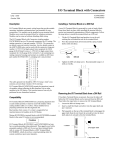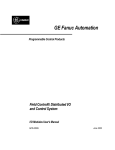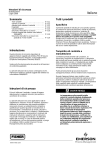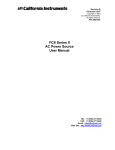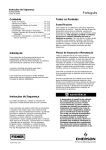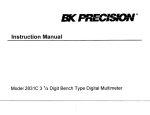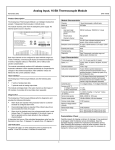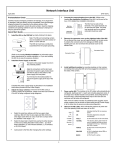Download to IC670ALG620 PDF for more information.
Transcript
This Datasheet for the IC670ALG620 RTD 4 Channel Isolated 3 or 4 Wire Input http://www.qualitrol.com/shop/p-14496-ic670alg620.aspx Provides the wiring diagrams and installation guidelines for this GE Field Control module. For further information, please contact Qualitrol Technical Support at 1-800-784-9385 [email protected] 10 Analog Input Module IC670ALG620 GFK-1206D June 1997 RTD Input Module RTD Input Module (IC670ALG620) datasheet GFK-1206D The RTD Analog Input Module (IC670ALG620) accepts inputs from 4 independent 3-wire and/or 4-wire platinum, nickel, nickel/iron, or copper RTDs. Module features include: H Selectable resistance measurements in tenths of ohms, tenths of degrees Fahrenheit, or tenths of degrees Celsius H H H H H H H Individual channel configuration Selectable resistance ranges: 0 – 500 ohms and 0 – 3000 ohms Selectable RTD input as resistance or temperature (Celsius or Fahrenheit) Reportshigh/low, underrange/overrange, open wire and input short alarms. Uses optional discrete inputs and outputs for status and control. Two data acquisition rates based on 50 Hz and 60 Hz line frequencies Configurable channel activation 46722 SLOT 4 3 2 1 Power Sources No loop power is required for this module. The excitation current for the RTDs is provided by the module, which automatically matches the excitation current to each configured RTD type. LED A single indicator shows module status: H H H ON: normal operation Intermittent flashing: module fault OFF: loss of backplane power or fatal fault Analog Input Module 2 GFK-1206D June 1997 RTD Input Module Module Operation The RTD Input Module accepts four inputs from three-wire or four-wire RTDs and converts the input level to a digital value. Input spans support a variety of RTD types, as listed in the Module Specifications section. The analog/digital converter reads the voltage generated by each of the four inputs. The A/D converter converts the differential measurement into a binary value (15 bits plus sign), which is read by the block’s microprocessor. The microprocessor sets the gain required in the analog/digital converter for each individual input. The gain is based on the RTD type that has been configured for that input. The microprocessor selects the input by means of a solid state, optically-coupled multiplexer. Three measurements are made for each input: Excitation current, RTD resistance including field wire drop, and field wire drop. From these three measurements, the module calculates the RTD resistance. A DC/DC converter circuit isolates the field side from the logic circuits. 2.5V Excitation Current Signal +5 V 5V DC/DC Regulator 6.5V –5 V FLASH Conditioning and Logic Multiplexer Opto Micro– processor Serial Bus A/D 2.5V Reference 46723 Calibration The module automatically performs A/D calibration at powerup. Automatic calibration is then repeated every minute to compensate for changes in the ambient temperature. The module stores the calibration constants for each gain in RAM memory. This data can be read and changed if necessary. Analog Input Module 3 GFK-1206D June 1997 RTD Input Module Host Interface The RTD Input module has the following data types: H H H H 4 analog inputs (4 words) 32 bits of discrete input data for module and channel status (use of this data is optional) 8 bits of discrete output data for fault clearing to the module (also optional) Analog output data defaults to a length of 0, and should NOT be used for most applications. A starting reference and length in the Bus Interface Unit (BIU) data tables for each data type is selected during module configuration. Depending on the configuration that has been set up for each RTD, the input data can be reported as tenths of ohms, tenths of degrees Fahrenheit, or tenths of degrees Celsius. This module exchanges data with a BIU in the same manner as other types of I/O modules—it provides all its input data and status bits when requested by the BIU, and receives fault-clearing commands from the BIU via its assigned output bits. Note that the BIU can be configured not to send status data over the network. The module can also be configured for “Group” data transfer with the BIU or with other intelligent devices in the same Field Control station. Group data transfer, and the steps for configuring it, are described in the Bus Interface Unit User’s Manual. UnitsSelected IntegerRanges EngineeringUnits Ranges Tenths of Degrees –32767 to +32767 –3276.7 to +3276.7 Tenths of Ohms 0 to 65535 0 Ohms to 6553.5 Ohms Compatibility This module must be used with a Bus Interface Unit revision 2.0 or later. Analog Input Module 4 GFK-1206D June 1997 RTD Input Module Module Configuration Overview Like other Field Control modules, the RTD Input module is usually configured from the Bus Interface Unit, using a compatible hand-held programmer. The module will also accept configuration data from the bus when used in a system that supports such configuration. The table below summarizes configuration choices and defaults. The module will power up with the default configuration settings. For configuration instructions, refer to the Bus Interface Unit User’s Manual. Description Default Choices Analog Input Data Length Word length of the module’s analog input data in the BIU’s analog input (AI) data table. 4 0–4 Analog Input Data Reference Starting offset for the module’s analog input data in the BIU’s analog input (AI) table. Discrete Input Data Length Bit length for the module’s optional status data in the BIU’s discrete input (I) table. Discrete Input Data Reference Starting offset for the module’s status data in the BIU’s discrete input (I) table. Discrete Output Data Length Bit length for the module’s optional fault-clearing bits in the BIU’s discrete output (Q) table. Discete Output Data Reference Starting offset for the module’s optional fault-clearing bits in the BIU’s discete output table. Analog Output Data Length Word length for analog output data in the BIU’s analog output (AQ) table. Should not be used for most applications. Analog Output Data Reference Starting offset for the module’s analog output data in the BIU’s AQ table. Line Frequency Specifies the line frequency. 60 Hz 50 Hz, 60 Hz Channel Active Specifies if the channel should return data and alarms. If a channel is “inactive” space is still allocated for it. Active Inactive (off), Active (on) Units The conversion type for each RTD. Deg C tenths of ohms, tenths of degrees C, or tenths of degrees F RTD Type The type of RTD used for each channel. 100 PT 385 10 PT, 25 PT, 25.5 PT 392, 100 PT 385, 100 PT 3902, 100 PT 392, 100 PT 3923, 100 PT 3916, 1K PT 375, 10 CU, 10 CU 427, 50 CU 427, 100 CU 427, 100 NI, 100 NI 618, 120 NI 672 604 NI/FE 518, 1K NI/FE 527, 500 Ohm, 3000 Ohm Wire Type The type of field wiring for each RTD. 3 Wire 3 Wire, 4 Wire Alarm Low The low alarm limit for the channel, in engineering units. –200 –32,768 to +32,767 Alarm High The high alarm limit for the channel, in engineering units. 800 –32,768 to +32,767 Resistance An optional resistance adjustment, in tenths of ohms. 0 0 to 3276.7 Module Parameter user selectable 32 0–32 user selectable 8 0–8 user selectable 0 0–4 user selectable Analog Input Module 5 GFK-1206D June 1997 RTD Input Module Module Features Channel Active Each channel can be configured as either active or inactive. If a channel is inactive, it is not scanned and a value of 0 is returned to the BIU. If a channel is active, and the configured analog input data length is not long enough to accommodate the data for a particular channel, the data for that channel is still processed, since the response to a group command may be used to transmit that channel’s data to the BIU. Low Alarm Limit and High Alarm Limit Each input channel can have a low alarm limit and a high alarm limit. If an input reaches one of its limits, the module reports the actual value and sends the appropriate diagnostic bit in the discrete input table of the BIU. Alarms do not stop the process or change the value of the input. Alarm limits can be set anywhere over the dynamic range of the signal. The range for each is – 32,768 to +32,767. The high alarm limit must be greater than the low alarm limit. If alarm reporting is not wanted, alarm limits can be set beyond the dynamic range of the signal so they will never be activated. Input Selection to Include RTD Type Each input channel can have a different RTD type, selectable from a list of many different RTDs. If the actual RTD resistance does not match the defined type, an adjustment factor can be configured in tenths of ohms. Selection Comments Selection Comments Selection Comments 10 PT 10 Ohm Platinum (PT) 100 PT 3916 100 Ohm Platinum, α=.003916 100 NI 618 100 Ohm Nickel At 0C, DIN43760, α=.00618 25 PT 25 Ohm Platinum IPTS-68 1K PT 375 1 KOhm Platinum, α=.00375 120 NI 672 120 Ohm Nickel, at 0C, α=.00672 25.5 PT 392 25.5 Ohm Platinum, α=.00392 at 0C Lab Std 10 CU 10 Ohm Copper, at 25C, IPTS-68 604NI/FE518 604 Ohm Nickel/Iron,at 0C, α=.00518 100 PT 385 100 Ohm Platinum, DIN43760, α=.00385 9.035 CU 427 9.035 Ohm Copper, at 25C, α=.00427 IKNI/FE527 1 KOhm Nickel/Iron, at 70F, α=.00527 100 PT 3902 100 Ohm Platinum, α=.003902 50 CU 427 50 Ohm Copper, α=.00427 500 OHM Select UNITS of 1/10 Ohms 100 PT 392 100 Ohm Platinum, α=.00392 IPTS-6 8 100 CU 427 100 Ohm Copper, α=.00427 3000 OHM Select UNITS of 1/10 Ohms 100 PT 3923 98.13 Ohm Platinum, α=.003923 100 NI 100 Ohm Nickel, IPTS-68 Analog Input Module 6 GFK-1206D June 1997 RTD Input Module RTD Limits The table below lists the ohms and temperature limits for different RTD types. RTD Type Low Ω Limit High Ω Limit Low Temp. C High Temp. C 10 Ohm Copper @ 25C 6.13600 14.8200 –75.00 150.00 10 Ohm Platinum @ 25C 7.02000 37.2599 –70.00 1000.00 25 Ohm Platinum 4.14500 74.3089 –201.1111 537.77 100 Ohm Nickel 80.88890 147.7700 –40.00 140.00 1 KOhm Platinum, α=.00375 199.4880 2754.620 –200.00 500.00 100 Ohm Platinum α=.00385 27.01 389.936 –180.0 850.0 100 Ohm Platinum, α=.003902 93.5400 135.000 –17.7777 99.9999 100 Ohm Platinum IPTS68 (PA) 26.5 327.744 –200.0 630.0 100 Ohm Platinum SAMA-RC21-4 (PC) 26.5 311.874 –200.0 600.0 100 Ohm Platinum JISC-1604-’81 26.5 323.780 –200.0 620.0 25.5 Ohm Platinum Lab Std (PJ) 4.50 83.575 –200.0 630.0 9.035 Ohm Copper (CA) 6.05 16.400 –100.0 260.0 50 Ohm Copper (CB/2) 28.379 105.787 –100.0 260.0 100 Ohm Copper (CB) 56.757 211.574 –100.0 260.0 100 Ohm Nickel (NB) 69.520 223.221 –60.0 180.0 120 Ohm Nickel (NA) 66.600 380.310 –80.0 260.0 604 Ohm Nickel/Iron(FA) 372.789 1318.722 –100.0 204.0 1 KOhm Nickel/Iron(FB) 566.576 1985.891 –100.0 204.0 Analog Input Module 7 GFK-1206D June 1997 RTD Input Module Module Specifications Module Characteristics Number of Channels Four 3-wire and/or 4-wire RTDs Scan time 60 Hz: approximately 210 milliseconds per point 50 Hz: approximately 230 milliseconds per point, Fault detection Open RTD, input short, underrange, overrange, and high/low alarm Normal mode rejection 60dB, at 50/60 Hz, 100% span Common mode rejection 120 dB at 50/60Hz, 100 ohm imbalance Common mode voltage 250 Vrms (350 VDC or peak AC) Normal mode voltage 100% overrange DC or peak AC operational 28 VDC or peak AC maximum Isolation: User input to logic, user input to frame ground. 1500 VAC for 1 minute, 250 VAC continuous. Channel to Channel 250 VAC continuous. Current drawn from BIU power supply 190 mA maximum DigitalResolution 15 bits plus sign Operating temperature range 0 to 55 Degrees C ambient Channel Characteristics RTD types 10, 25, 100, and 1000 ohm platinum 10 and 100 ohm copper 100, 50, and 120 ohm nickel 604 ohms and 1000 ohms nickel/iron Resistanceranges 0 to 500 ohms 0 to 3000 ohms Accuracy, at 25 C RTD: +/–0.15% of reading, +/–0.3 to 0.5 degree Celsius, depending on type Temperature sensitivity (0 to 60C) +/–0.004% of reading, +/–1.5µV per C referred to input Maximum lead resistance 5 ohms per lead Keying Locations Optional keying locations for the RTD Module are: KeyingLocations A n B C D n E F G H n J n K Analog Input Module 8 GFK-1206D June 1997 RTD Input Module Field Wiring The following illustration shows connections for 3-wire and 4-wire RTDs. Required for Calibration if no RTD is Installed 4-Wire RTD 3-Wire RTD Corresponding Terminals Source Source Source 7 8 15 16 In (+) In (+) In (+) 5 6 13 14 In (–) In (–) In (–) 3 4 11 12 Return Return Return 1 2 9 10 46724 No loop power is required for this module. The excitation current for the RTDs is provided by the module, which automatically matches the excitation current to each configured RTD type. I/O Terminal Block Terminal Assignments The Terminal Block with box terminals (IC670CHS002) has 25 terminals for each module. Each accommodates one AWG #14 (avg 2.1mm2 cross section) to AWG #22 (avg 0.36mm2 cross section) wire, or two wires up to AWG #18 (avg. 0.86mm2 cross section). When an external jumper is used, wire capacity is reduced from AWG #14 (2.10mm2) to AWG #16 (1.32mm2). The I/O Terminal Block with barrier terminals (IC670CHS001) has 18 terminals per module. Each terminal can accommodate one or two wires up to AWG #14 (avg 2.1mm2 cross section). The I/O Terminal Block with Connectors (IC670CHS003) has one 20-pin male connector per module. I/O Terminal Block with Box Terminals (IC670CHS002 and 102) Source 4 In (+) 4 not used In (–) 4 Return 4 not used Source 2 In (+) 2 not used In (–) 2 Return 2 not used not used not used 16 14 E8 12 10 E6 8 6 E4 4 2 E2 B2 B1 15 13 11 9 Source 3 In (+) 3 In (–) 3 Return 3 7 5 Source 1 In (+) 1 3 1 E1 A2 A1 In (–) 1 Return 1 not used not used not used I/O Terminal Block with Barrier Terminals (IC670CHS001 and 101) Source 4 16 In (+) 4 14 In (–) 4 12 Return 4 10 Source 2 8 In (+) 2 In (–) 2 6 Return 2 2 not used B 4 15 11 Source 3 In (+) 3 In (–) 3 9 Return 3 7 Source 1 5 In (+) 1 3 In (–) 1 Return 1 not used 13 1 A I/O Terminal Block with Wire to Board Connectors (IC670CHS003 and 103) In (–) 3 In (–) 4 In (+) 3 In (+) 4 Source 3 Source 4 not used not used not used not used 11 10 12 9 13 8 14 7 15 6 16 5 A2 4 A1 3 B2 2 B1 1 Return 4 Return 3 Source 2 Source 1 In (+) 2 In (+) 1 In (–) 2 In (–) 1 Return 2 Return 1 Ter minals E1, E2, E4, E6, and E8 are electrically connected together, A1 and A2 ar e electrically connected together, B1 andB2 are electrically connected together. 46725 Analog Input Module 9 GFK-1206D June 1997 RTD Input Module Diagnostics The RTD module performs diagnostics and provides the diagnostic data to the BIU using its configured discrete input (I) references, starting at the configured reference offset. The RTD sets the appropriate bit when a diagnostic condition is detected. The bit remains set until cleared. Circuit Diagnostics Bits (byte 0) 7 6 5 4 3 2 1 0 Circuit Diagnostics Bits (byte 2) 7 6 5 4 3 2 1 0 Low alarm for RTD 1 High alarm for RTD 1 Low alarm for RTD 2 High alarm for RTD 2 Low alarm for RTD 3 High alarm for RTD 3 Low alarm for RTD 4 High alarm for RTD 4 Open Wire, RTD 1 Open Wire, RTD 2 Open Wire, RTD 3 Open Wire, RTD 4 Shorted input, RTD 1 Shorted input, RTD 2 Shorted input, RTD 3 Shorted input, RTD 4 Circuit Diagnostics Bits (byte 3) 7 6 5 4 3 2 1 0 Circuit Diagnostics Bits (byte 1) 7 6 5 4 3 2 1 0 Input underrange, RTD 1 Input overrange, RTD 1 Input underrange, RTD 2 Input overrange, RTD 2 Input underrange, RTD 3 Input overrange, RTD 3 Input underrange, RTD 4 Input overrange, RTD 4 Wiring error, RTD 1 Wiring error, RTD 2 Wiring error, RTD 3 Wiring error, RTD 4 spare spare spare spare Clearing Faults and Alarms Four optional discrete output bits in the BIU’s discrete output (Q) table can be used to clear module faults and alarms. Setting the discrete output bit for an RTD clears all diagnostic bits for that RTD that may be set. Output Command Bits to Clear Diagnostics 7 6 5 4 3 2 1 0 Clear All Faults on RTD 1 Clear All Faults on RTD 2 Clear All Faults on RTD 3 Clear All Faults on RTD 4 not used not used not used not used











